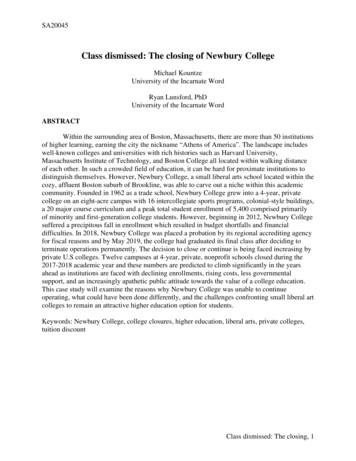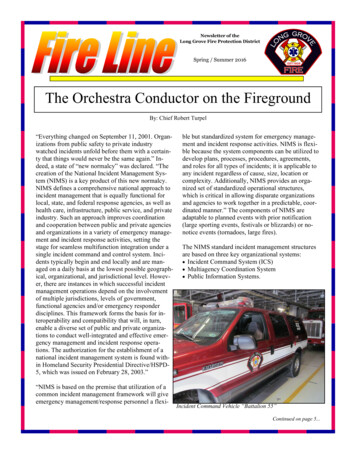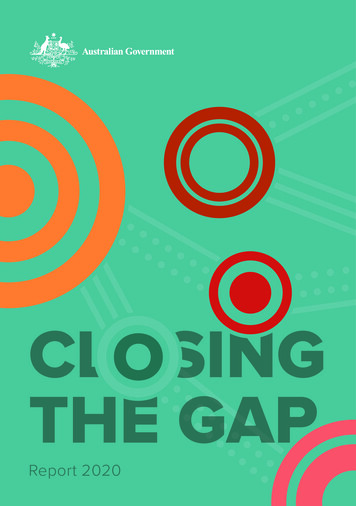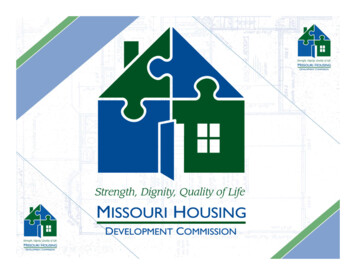
Transcription
SA20045Class dismissed: The closing of Newbury CollegeMichael KountzeUniversity of the Incarnate WordRyan Lunsford, PhDUniversity of the Incarnate WordABSTRACTWithin the surrounding area of Boston, Massachusetts, there are more than 50 institutionsof higher learning, earning the city the nickname “Athens of America”. The landscape includeswell-known colleges and universities with rich histories such as Harvard University,Massachusetts Institute of Technology, and Boston College all located within walking distanceof each other. In such a crowded field of education, it can be hard for proximate institutions todistinguish themselves. However, Newbury College, a small liberal arts school located within thecozy, affluent Boston suburb of Brookline, was able to carve out a niche within this academiccommunity. Founded in 1962 as a trade school, Newbury College grew into a 4-year, privatecollege on an eight-acre campus with 16 intercollegiate sports programs, colonial-style buildings,a 20 major course curriculum and a peak total student enrollment of 5,400 comprised primarilyof minority and first-generation college students. However, beginning in 2012, Newbury Collegesuffered a precipitous fall in enrollment which resulted in budget shortfalls and financialdifficulties. In 2018, Newbury College was placed a probation by its regional accrediting agencyfor fiscal reasons and by May 2019, the college had graduated its final class after deciding toterminate operations permanently. The decision to close or continue is being faced increasing byprivate U.S colleges. Twelve campuses at 4-year, private, nonprofit schools closed during the2017-2018 academic year and these numbers are predicted to climb significantly in the yearsahead as institutions are faced with declining enrollments, rising costs, less governmentalsupport, and an increasingly apathetic public attitude towards the value of a college education.This case study will examine the reasons why Newbury College was unable to continueoperating, what could have been done differently, and the challenges confronting small liberal artcolleges to remain an attractive higher education option for students.Keywords: Newbury College, college closures, higher education, liberal arts, private colleges,tuition discountClass dismissed: The closing, 1
SA20045INTRODUCTIONTwo years into his presidency of Newbury College, Joseph Chillo was clearly proud ofhis administration’s accomplishments since his inauguration in June 2014. In a 2-minutepromotional video for the college, Chillo explained to the audience that 7 million in funds hadbeen raised resulting in the construction of a new student lounge and fitness center as well asrenovations to enlarge the dining facilities. Additionally, under Chillo’s leadership, faculty weregiven the freedom to create innovative curriculum which dramatically improved the English andmath scores of Newbury College students and the library was transformed into the StudentSuccess Center, a facility which provided tutoring programs, research services and greaterstudent access to faculty. These efforts culminated in Newbury College receiving the 2016American Council on Education/ Fidelity Investments Award for Institutional Transformationwhich recognized institutions that have “responded to higher education challenges in innovativeand creative ways and achieved dramatic changes in a relatively brief period” (American Councilon Education, 2016). Furthermore, in 2016, Newbury College had been re-accredited by the NewEngland Association of Schools and Colleges and in 2017 and 2018, Newbury College would berecognized by US News and World Report as one the Best Regional Colleges in the North.Chillo was the fifth president in the institution’s history which had become a haven forminority, low-income, and first-generation college students from mainly the New England area.Nearly all of its students were receiving some sort of financial aid. Chillo himself was a firstgeneration student having graduated with a Bachelor of Arts from State University of New YorkBinghamton (Northern Kentucky Tribune, 2019). He went on to complete his Master of PublicAdministration from Long Island University and a Doctor of Law and Policy from NortheasternUniversity. Prior to being named Newbury College president, Chillo served in variousenrollment, strategic planning and marketing roles with several colleges over a 25-year career.He had been executive vice president at Newbury College before being appointed president bythe Board of Trustees.Despite his list of successes, there were also signs of weak performance at NewburyCollege under the Chillo administration. What Chillo did not mention in the video is that fallstudent enrollment had fallen by 14% from 2014 to 2016. (National Center for EducationStatistics [NCES], 2020). The 2016 six-year graduation rate, which is the standard number ofyears to complete a 4-year degree, stood at 34%, well below the average of 66% at privatenonprofit colleges (NCES, 2020). The Newbury College retention rate for that same year, whichmeasures the percentage of first-year undergraduates that return to the same institution thefollowing fall, was 57% as compared to the national average of 74% (NCES, 2020) . Newbury’sfinancial stability score, a rating determined by the U.S. Department of Higher Education tomeasure the financial condition of U.S. colleges and universities, stood at 1.7, barely above theacceptable standard of 1.5.By the summer of 2018, the financial burdens of the college had worsened. The NewEngland Commission of Higher Education, the regional accreditation agency overseeingNewbury College, placed the institution on probation for two years for violation of StandardSeven – Institutional Resources. Chillo expressed optimism that Newbury would turn thesituation around and explored solutions such as a merger with another college and the sale of itsreal estate. However, on December 14, 2018, Chillo made the somber announcement during ameeting with his faculty and administration that after 57 years of operation, Newbury Collegewas closing at the end of the Spring 2019 semester.Class dismissed: The closing, 2
SA20045BACKGROUNDIn its nearly 60-year existence, Newbury College went through a number of uniquephases starting with its roots in 1962 as a business trade school. Edward Tassinari, a native ofBoston and former Army munitions instructor, operated the Boston franchise of the AmericanTraining School which specialized in teaching skills such as switchboard operations, shorthandand typing. When the parent company went bankrupt, Tassinari bought his location, renamingthe school the Newbury College of Business since the school was situated on Newbury Street.From its humble beginnings as a secretarial school, the Newbury College of Businessgrew into a nonprofit, accredited two-year school by the early 1970s where students could earnan associate degree. This prompted Tassanari to change the name to Newbury Junior College.The institution continued to enlarge during the 1970’s through acquisitions of nearby collegesand expanded course offerings. As a result, Newbury grew to 15 satellite campuses spreadthroughout the Boston area (Brookline Preservation Commission, 2019). When Tassanariacquired Cardinal Cushing College in 1982, Newbury established its central location in theFisher Hill section of Brookline, a neighborhood known for its colonial-style estates and wealthyresidents. Fisher Hill is listed in the National Register of Historic Places and Brookline is knownas the birthplace of the 35th president of the United States, John F. Kennedy.In 1985, the school began offering both associate and bachelor’s degrees and in 1994, theinstitution changed its name a final time to Newbury College. Enrollment of full-time and parttime students peaked at nearly 5,400 in 1996 (NCES, 2020) and Tassanari retired two years later.By this time, Newbury had also established a reputation as one of the top culinary schools in theregion. Roy Nirshel was installed as the next president of Newbury College but previousinvestments had saddled the college with 18 million in liabilities (NCES, 2020). Expenses werealso outpacing revenues forcing the college to remove several academic programs (O’Malley,2019). Nirshel held the leadership position from 1998 to 2001 before leaving to becomepresident of Roger Williams University in Rhode Island. The Nirshel cutbacks, which gavestudents less course offerings, resulted in a significant decline in enrollment for Newbury. From1998 to 2001, full-time enrollees fell by 31% from 952 to 654. During the same period, thenumber of part-time students dropped from 2,442 to 1,035, a 58% decline. In subsequent years,the number of full-time students would eclipse total part-time students as shown in Figure 1.Under the Nirshel administration, Newbury did receive accreditation by the New EnglandCommission of Higher Education (NECHE), the regional accreditation agency of colleges anduniversities within the six New England states. Recognized by the U.S. Department of Educationand the Council for Higher Education Accreditation, the NECHE accreditation was an importantstep in the growth of Newbury. With the NECHE accreditation, Newbury College was able to a)receive federal funds for student financial aid; b) more easily transfer student credits to anotherinstitution; and c) validate the worth of its degree with graduate schools and employers.David Ellis served as the third president of Newbury College from 2001 to 2006. TheNECHE accreditation had a positive effect on enrollment as the number of full-time studentsincreased to over 900 under the Ellis administration, the highest level in nearly a decade. Thecollege was even turning a profit at this time. Ellis’ financial turnaround of Newbury was noticedby Emerson College and he left Newbury in the summer of 2006 to become their Chief FinancialOfficer. Hannah McCarthy, a former president of Daniel Webster College in New Hampshire,was named the successor to Ellis. McCarthy’s term coincided with the financial crisis of 2008.The collapse of several financial institutions in 2008 was tied to the crash in the housing market.Parents that had financed the post-secondary educations of their children using home equity linesClass dismissed: The closing, 3
SA20045in the past could no longer, as home values fell. Colleges and universities responded bysubstantially discounting their education prices to attract students (Selingo, 2018). The averagetuition discount percentage Newbury gave to its students rose steadily from academic year 2008 2009 and is shown in Figure 2.The 2008 recession actually spurred many students to get an education to secure a joband total enrollment at private, nonprofit institutions spiked the next few years. By this time, thebusiness model for Newbury College was clearly concentrated on attracting the 4-year collegestudent as adult education classes were eliminated (O’Malley, 2019). This came at a costhowever as the Newbury graduation rate, measured over a six-year period from the start to finishof an undergraduate degree, hovered between 30% and 40% between 2008 and 2014. Thenational average graduation rate for those same years was 65% for 4-year, private, nonprofitinstitutions (NCES, 2020). Many students that Newbury College accepted were ill-prepared forthe rigors of a college curriculum and either dropped out or failed academically.NEWBURY COLLEGE AND BROOKLINE RELATIONSHIPIn the two-minute YouTube video, “We Love Newbury!”, Newbury students givetestimonials why they enjoy attending the school. The short film displays the diversity of thestudent population as young men and women representing various backgrounds and cultures givetheir answers into the camera. The latest figures gathered from Newbury showed that 72% of theundergrads at Newbury were of minority descent (NCES, 2020). The median family income of aNewbury College student was a reported 59,300 (New York Times, 2017). This stood in starkcontrast to the city where the campus was located. Brookline had a 74% Caucasian populationwhere median household income and home value was 111,000 and 829,000 respectively.There was a clash between the college and its city from the start when the founder of Newbury,Edward Tassinari, applied to have dormitories on campus in 1992. The previous tenant, CardinalCushing College, had used the same buildings as dormitories but when Tassinari tried tocontinue their use as student lodgings, he was met with resistance from the Town of Brooklineselectmen. Tassinari was forced to sue in the court for the right to provide housing for hisstudents. He ultimately won but it set the tone for an icy relationship between the town and thecollege.In 1994, Tassinari tried to buy nearby a parcel of land in Brookline to expand theboundaries of Newbury. The local residents fought the move citing “the continued unrestrictedexpansion of Newbury College endangers the residential character of Fisher Hill” (Abrahms,1994). As a nonprofit institution, any expansion of real estate by Newbury would not bring in taxrevenue to Brookline. After nine months of bitter negotiations with the Town, Tassinari decidedto move forward with 3 million in building improvements within the confines of the existingcollege.The relationship between Newbury and Brookline began to soften when NewburyCollege opened its newly constructed 16,000-foot, 4 story library on October 22, 1997. Thelibrary drew accolades from the surrounding community since it was built without expandinginto Brookline and the library was made accessible to the public. Tassinari’s successor, RoyNirschel, also made it a point to have a good relationship with the Town and invited theneighborhood association to lectures and concerts on campus (Abrahms, 1998). In 2001, thePresidential Order of Merit was given to Brookline by Newbury College for the town’s help inextinguishing a fire that destroyed the third floor of a school building (Boston Globe, 2001).Class dismissed: The closing, 4
SA20045Town officials were instrumental in preserving vital school records and avoiding any disruptionof student classes.FACTORS IMPACTING SMALL PRIVATE COLLEGE CLOSURESNo student enrolls in a college expecting the institution to close while they areattending. However, for the 4-year, private, nonprofit college, closings are happening withincreased frequency. According to the National Center for Education, there were 12 closings inboth 2016 and 2017, a sharp upward spike from the years 2010 to 2015 when there was anaverage of 4 closings per year. These figures are predicted to rise in the coming years for severalreasons, summarized below.Student DebtThere is a growing concern among graduating high school seniors on whether taking onstudent debt to attend college in a worthwhile investment. Figures from The Institute for CollegeAccess & Success show 82% of Newbury College students had debt upon graduation with anaverage amount of 30,800. The current total student debt in the U.S. is 1.6 trillion dollars andcollege students are increasingly seeing the experience as a means to secure employment, ratherthan to develop their learning and comprehension skills. In a 2018 Harris Poll, 66% of thecollege students surveyed said their reason for attending college was to secure a well-paying job.The amount of student debt assumed by college graduates is causing high school students toconsider less expensive specialized technology certifications or “job-ready” majors such ashealthcare, accounting, and computer science typically offered at public universities rather thanthe humanities taught at liberal arts colleges.Financial VulnerabilityA 2016 report by the accounting firm of Ernst & Young found 735 U.S. colleges withenrollments less than 1,000 were susceptible to closing based on an assessment of risk factors.Among the traits identified were: No online education programs. Tuition discounts were 35% or greater. Tuition dollars comprised 85% or more of revenue. Endowment covered less than 33% of expenses.Newbury College fit all four of these criteria. Schools exhibiting these risk factors arevulnerable to any decreases in enrollment, unexpected expenses or downswings in the economy.Moody’s Investor Service also analyzed the fiscal strength of small private colleges in the U.S.and concluded that 20% are experiencing financial stress (Cohn, 2019).Class dismissed: The closing, 5
SA20045The Birthrate DeclineThe overall number of students attending U.S. degree-granting postsecondary institutionsfell by 8% from 2011 to 2018 (NCES, 2020). In the coming years, this trend is expected tocontinue since the Great Recession of 2008 resulted in Americans having less babies. Thatfinancial crisis caused potential parents to think twice about the associated monetaryresponsibilities of having a family. There were 2.3 million less births during the period of 2008to 2013 when compared to pre-recession fertility rates (Johnson, 2014). The full impact of thebirth rate decline from the 2008 financial crisis will be felt in 2026 and beyond when thosepotential 18-year old college freshmen will not be enrolling.Tuition DiscountingPrivate colleges and universities have been steadily offering increased tuition discounts toundergraduates in order to attract more students. The tuition discounts make the institution moreaffordable for low to moderate income students while keeping the tuition price intact for studentsthat can pay the full cost. From 2005 to 2018, the average student discount for incomingfreshmen rose from 38% to 50% (Eide, 2018). However, what is counterintuitive is that, formany colleges, the discounts have failed to attract more students, or even maintain enrollmentlevels. Newbury College fit this example. During the 5-year period of 2012 to 2017, theNewbury College average student discount rose 13%, from 42% to 55%, while the number offull-time students declined from 883 to 543 (NCES, 2020).The Closing of Newbury CollegeWhen a college closes its doors, it is similar to the dissolvement of a company however thereare some distinct differences. A business bankruptcy can seem impersonal as it can take years tounwind the assets, pay off creditors and sort out legalities in court. Company employees, whileaffected, are usually able to move on with their lives. The ripple effect of a small private collegeclosing is felt by young students, parents, administrators, professors and other workers, leaving adeep void in the community. Local businesses that are dependent on the college for commercecan see their prime source of revenue dry up. Students and parents are left scrambling to findanother institution that is compatible socially, financially, and academically.There is evidence that school officials at Newbury College knew a year prior to closing, thecollege was in a vulnerable financial position. A note in the June 30, 2017 Audited Statementsfor Newbury College Inc., prepared by the accounting firm of O’Connor and Drew P.C. andpublished on December 12, 2017 reads:Management acknowledges that uncertainty remains over the ability to sustain the long-termfinancial stability of the College, however, they believe the above steps are viable andachievable and will enable the College to meet its funding requirements and obligations asthey become due in the ordinary course of business, for a period of twelve months followingthe date these financial statements are available to be issued. For the long-term, managementis considering all alternatives including revamping its curriculum and program offerings toincrease enrollment and decrease expenses (p. 25).Despite the admittance of being in a precarious financial position, Newbury College was nottransparent in letting the public know its fiscal troubles. When Mount Ida College in Newton,Class dismissed: The closing, 6
SA20045Massachusetts announced in April 2018 that it would closing the next month, Newbury Collegepersonnel actively recruited the newly displaced students, even developing a dedicated webpageexplaining the ease of the transfer process and urging the former Mount Ida College students tobecome members of their fall 2018 class. While the webpage made several promises such as “wewill also match your net price at Mount Ida until you graduate from Newbury College” and “wewill have a special admission process for all Mount Ida College students”, there was no mentionof the institution’s financial instability. The very next year, any Mount Ida College transferees toNewbury College were looking for their third school in two years when Newbury closed in May2019.Before closing, Newbury was successful in transferring at least 90% of its remainingstudents to other institutions by signing partnerships with thirteen other college and universities(Burns, 2019). These agreements guaranteed the admission of a Newbury College student to apartner institution. One of the partnering colleges was Lasell College which would become thecontact institution for student records and transcripts after Newbury’s closure. A copy of thememorandum of understanding (MOU) between Newbury and Lasell, now known as LasellUniversity, is shown in Figure 3. The MOU is dated December 18, 2018, only 4 days afterNewbury’s closing announcement, which implies that school officials were planning andnegotiating with other colleges several weeks before the public declaration.Newbury College had discussions and explored merging with several local colleges butthe talks all eventually broke down. Newbury had a deal in principal with Global UniversitySystems, an education company based in the United Kingdom, which would have eliminated thecollege’s debt and provided a healthy endowment however Global ended the negotiations. IfNewbury had been able to close that deal, in all likelihood, it would still be operating today.CONCLUSIONThe financial demise of Newbury College was fairly swift. Within a two-year span, thecollege went from winning a nationally recognized award for being an innovative leader ineducation to shutting its doors forever. While there were warning signs before the collegeultimately closed, the larger problem was there was no long-term solution to keeping the collegeafloat in future years. An endowment-poor college that is heavily dependent on a single revenuestream, in this case the discounted tuition of undergraduate students, can only keep the lights onfor long. Unfortunately, the Newbury College situation is symbolic of many U.S. 4-year, private,nonprofit colleges. Below is a list of five factors that could have possibly prevented theliquidation of Newbury College. Attracted adult students. There is one huge pool of potential students that no school canafford to overlook – adults returning to college. Estimates show there are 36 millionAmericans, mainly adults, that either have no or some college. Even President Chillo, inan interview before Newbury College shut down said “we should’ve been doing online,we should’ve been developing a graduate program.” Remained a two-year degree school. Before expanding into baccalaureate degrees,Newbury awarded only associate degrees and the college was financially stable. Newburyhad carved out a unique niche in the Boston market as a junior college and at one point,was the largest private two-year institution in the U.S. (Alcomber, 2019). When Newburybecame a 4-year college, it had to compete in the saturated Boston college and universityenvironment for students. Newbury found it tougher to attract students and this ultimatelyClass dismissed: The closing, 7
SA20045led to lower enrollment. Other small, private college have found ways to distinguishthemselves from the competition and increase enrollment (Marcus, 2019). Shared costs. With so many neighboring colleges, Newbury could have developedpartnerships to share and distribute operating costs. Costs such as campus safety, foodservices, grounds maintenance, and facilities management could have been pooled withother colleges. An example would be the Five College Consortium in westernMassachusetts where five higher education institutions, all located within a short distanceof each other, collaborate to share workers, services, resources, and facilities. Expanded recruitment. Newbury drew primarily from the local population for students.Eighty percent of incoming students in 2018 where from states located in the Northeast.The college should have recruited in other parts of the United States to attract students aswell as internationally. As a further incentive, international students typically pay fulltuition, not a discounted rate, when they attend U.S. schools. Financial transparency. And lastly, Newbury College should have been moreforthcoming in sharing financial information with administrators, professors and studentslong before announcing the closing of the school. Even after Newbury was placed onprobation for financial concerns in the summer of 2018, school officials still gave theimpression the school would be fine. The college could have formed a task force ofstakeholders to develop strategies to keep the institution open. Town halls, meetings, andother forms of communication would have engaged all those involved and created ashared vision for improving the financial health of the college.The legacy of Newbury College will live on through its graduates, many of whom were notgiven a chance to attend college anywhere else. As for the campus, it is being converted to seniorhousing after being sold to a developer. The closure of Newbury College and other local areacollege closures also prompted governmental action. The state of Massachusetts in November2019 passed a law requiring its colleges and universities to notify the Board of Higher Educationof any potential risks of closure. Going forward, the Board of Education will annually screen andmonitor the financial condition of these postsecondary institutions. Hopefully, strong legislativemeasures coupled with proactive, long-range thinking by college management will protect thefinancial well-being of these institutions. The survival of the small, liberal arts college dependson it.Class dismissed: The closing, 8
SA20045REFERENCESAbrahms, S. (1994, December 11). Battle brews over Fisher Hill. The Boston Globe, p. 264.Abrahms, S. (1998, May 31). College president adopts good neighbor policy. The Boston Globe,p. 285.Alcomber, M. (2019, March 20). Newbury College to close its doors following financialstruggles. Ed Greable & Company. Retrieved from doors-following-financial-struggles/American Council on Education. (2016, March 13). Fayetteville State University and NewburyCollege received ACE/Fidelity Investments Award for Institutional Transformation.Retrieved from rmation.aspxBrookline Notes. (2001, September 16). The Boston Globe, p. 227.Brookline Preservation Commission. (2019). Brookline Preservation Commission DemolitionApplication Report. Retrieved w/20778/Holland-Rd 124-DemoReport November-2019?bidId Burns, H. (2019, April 26). As Newbury College winds down, admissions office looks to placetransfers. The Boston Business Journal. Retrieved e.htmlCohen, M. (1994, September 18). Mom-and-pop schools flourishing. The Boston Globe, p.117.Cohn, S. (2019, December 3) The other college debt crisis: Schools are going broke. CNBC.Retrieved from ly. (n.d). Newbury College – Brookline Student Loan Refinance Options. Retrievedfrom s/Education Dive (n.d.) How many nonprofit colleges and universities have closed since 2016?Retrieved from ide, S. (2018). Private colleges in peril. EducationNext. Retrieved sures/Ernst & Young (2016). Strength in numbers: Strategies for collaborating in a new era for highereducation. Retrieved from https://www.ey.com/Publication/vwLUAssets/EY Strength in numbers: Higher education collaboration report/ File/EYParthenon Strength-inNumbers-CollaborationStrategies Final singles 082016.pdfEvancie, A. and Noyes, A. (2020, February 7). As colleges close, how will Vermont schoolssurvive? VPR. ermont-schoolssurvive?utm source VBM Mailing List&utm campaign 12bfe9399aENEWS 2020 02 12&utm medium email&utm term 0 b5e56b36a4-12bfe9399a286698013#stream/0Class dismissed: The closing, 9
SA20045eZ-Audit (2018, May 1). Composite scores for private, non-profit, and proprietary institutionsfor fiscal years ending between 7/1/2015 and 6/30/2016. Retrieved osite-scoresJohnson, K. (2014). The hidden cost of the recession. Carsey Research – National Fact Sheet#26. Retrieved rticle 1230&context carseyLauerman, J. (1997, November 2). College library draws neighborhood praise. The BostonGlobe. p. 289.Logan, T. (2019, September 12). Newbury College campus sold for 34 million, will becomesenior housing. The Boston Globe. Retrieved using/KJzJtJPWnynOVpuGIGKsPM/story.htmlMarcus, J. (2019, October 10). Radical survival strategies for struggling colleges. The N
cozy, affluent Boston suburb of Brookline, was able to carve out a niche within this academic community. Founded in 1962 as a trade school, Newbury College grew into a 4-year, private . With the NECHE accreditation, Newbury College was able to a) receive federal funds for student financial aid; b) more easily transfer student credits to .











